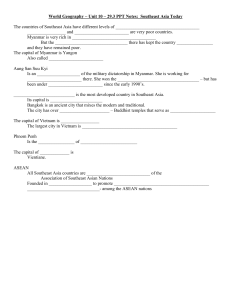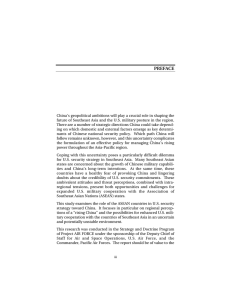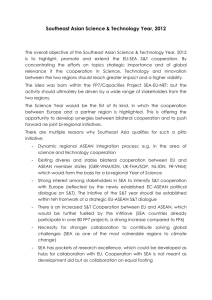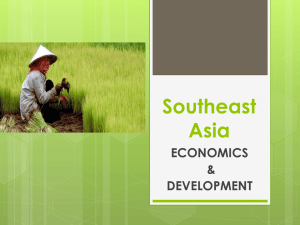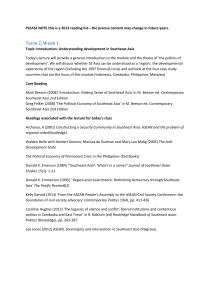U.S. OBJECTIVES AND INTERESTS IN SOUTHEAST ASIA
advertisement
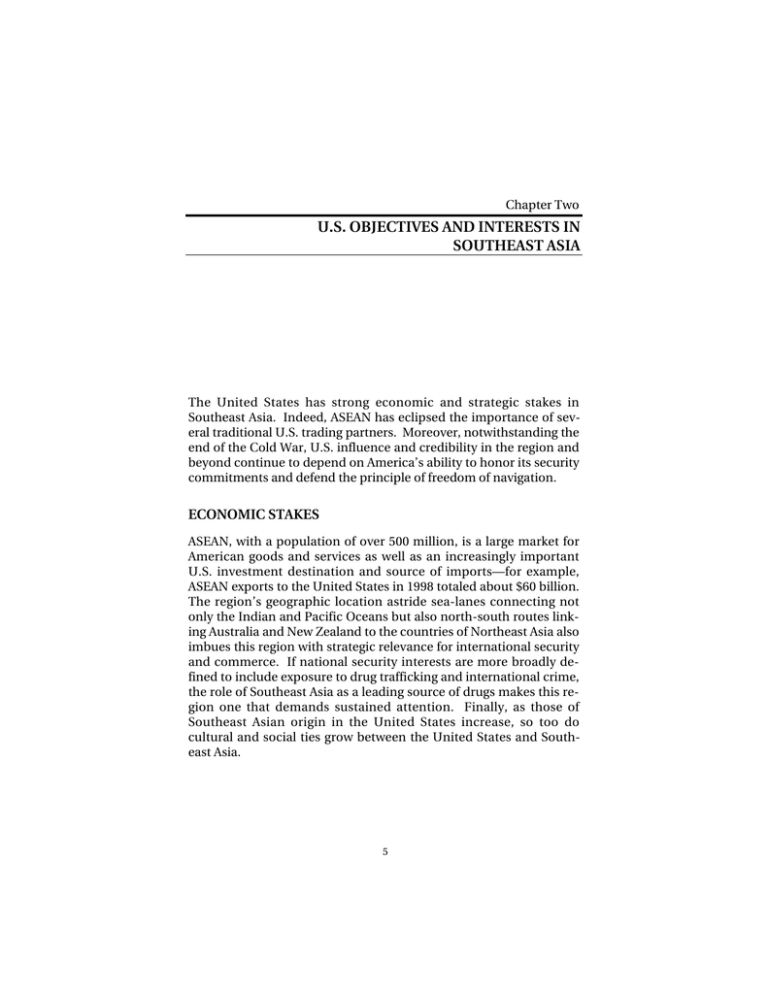
Chapter Two U.S. OBJECTIVES AND INTERESTS IN SOUTHEAST ASIA The United States has strong economic and strategic stakes in Southeast Asia. Indeed, ASEAN has eclipsed the importance of several traditional U.S. trading partners. Moreover, notwithstanding the end of the Cold War, U.S. influence and credibility in the region and beyond continue to depend on America’s ability to honor its security commitments and defend the principle of freedom of navigation. ECONOMIC STAKES ASEAN, with a population of over 500 million, is a large market for American goods and services as well as an increasingly important U.S. investment destination and source of imports—for example, ASEAN exports to the United States in 1998 totaled about $60 billion. The region’s geographic location astride sea-lanes connecting not only the Indian and Pacific Oceans but also north-south routes linking Australia and New Zealand to the countries of Northeast Asia also imbues this region with strategic relevance for international security and commerce. If national security interests are more broadly defined to include exposure to drug trafficking and international crime, the role of Southeast Asia as a leading source of drugs makes this region one that demands sustained attention. Finally, as those of Southeast Asian origin in the United States increase, so too do cultural and social ties grow between the United States and Southeast Asia. 5 6 The Role of Southeast Asia in U.S. Strategy Toward China Despite the turbulence caused by the Asian economic crisis, ASEAN remains an important U.S. trading partner—the destination of some $40 billion in U.S. merchandise exports and the source of $78 billion in U.S. merchandise imports in 1999.1 In recent years, ASEAN has been second only to Japan and well ahead of China, Hong Kong, and Korea in terms of U.S. merchandise exports to the Pacific Rim. The level of U.S. merchandise imports from ASEAN has been less than from Japan, but similar to the level of imports from China, and much greater than imports from Korea and Hong Kong (see Table 2.1). U.S. exports to ASEAN are significant and expected to resume robust growth when regional purchasing power recovers from the effects of the financial crisis.2 There is potential for further growth in United States-ASEAN trade as structural changes in the region’s economies increase the value of the service and high-tech sectors, where U.S. Table 2.1 U.S. Trade with Asia: 1996–1999 (millions of U.S. dollars) Year China Japan Hong Kong Korea ASEAN 1996 1997 1998 1999 Sum 11.933 12.862 14.241 13.118 67.607 65.549 57.831 57.484 Exports 13.966 15.117 12.925 12.647 26.621 25.046 16.486 22.954 43.631 48.271 39.37 39.873 171.145 1996 1997 1998 1999 Sum 51.513 62.558 71.169 81.786 115.187 121.663 121.845 131.404 22.655 23.173 23.942 31.262 66.427 71.014 73.395 77.67 288.506 Imports 9.865 10.288 10.538 10.531 SOURCE: U.S. Department of Commerce, Bureau of the Census, Foreign Trade Division, www.census.gov/foreign-trade/balance/index.html ______________ 1 U.S. Department of Commerce, Bureau of the Census, Foreign Trade Division, at www.census.gov/foreign-trade/balance/index.html 2U.S.-ASEAN Business Council, ASEAN Market Overview, June 1999, p. 2. U.S. Objectives and Interests in Southeast Asia 7 companies have competitive advantages. Furthermore, although in absolute terms ASEAN’s total nominal gross domestic product (GDP) in 1997 of about $675 billion is roughly comparable to that of one of the largest American states,3 this figure belies the importance and attractiveness of ASEAN as a market for American goods and services. This total GDP figure, and related per capita income statistic of about $1300, masks the exceptionally wide range of per capita incomes, ranging from a low of $250 in Vietnam to a high of more than $20,000 in Singapore and Brunei,4 as well as diverse levels of socioeconomic development. Because these markets range from the largely agricultural to the highly sophisticated post-industrial, they complement the diversity of goods and services produced by the U.S. economy and therefore offer a well-balanced growth opportunity for American exports. ASEAN is also a major destination for American foreign investment, as measured by foreign direct-investment positions. From 1990 to 1997, U.S. foreign direct investment in the region climbed from $11.8 billion to $37.5 billion, surpassing U.S. investment in both Japan and Brazil of $35.6 billion and $35.7 billion, respectively.5 Perhaps more surprising, U.S. direct investment in ASEAN was seven times greater than that in China and almost double that in Hong Kong.6 While the Asian financial crisis sharply reduced capital inflows to the ASEAN countries, most observers expect the return of portfolio capital to regional equity markets as the recovery takes hold.7 The changing complexion of American investment in ASEAN also points to the growing economic importance of this region to the United States. In the 1980s, most investment centered on the oil and ______________ 3According to the U.S. Department of Commerce, Statistical Abstract of the United States, 1998, No. 719, the gross state product of California and New York in 1996 were $880 billion and $563 billion, respectively. 4U.S.-ASEAN Business Council, p. 2. 5Statistical Abstract, 1998, No. 1312; Survey of Current Business, July 1998, p. 43, Table 3.2. Estimates of portfolio investment are problematic. The fact that U.S. direct investments in ASEAN surpass those in Japan may be partially explained by Japanese restrictions on large equity investments by foreigners, which makes it harder for U.S. investors to meet the U.S. definition of direct investment (10 percent ownership). 6Statistical Abstract, 1998, No. 1312. 7See Asian Development Bank, Asian Development Outlook 1999, Manila, p. 7. 8 The Role of Southeast Asia in U.S. Strategy Toward China gas sector. However, in 1997, oil and gas had fallen to 29 percent of total investment while manufacturing and services accounted for 37 percent and 34 percent, respectively. 8 Sustained growth in per capita incomes as well as the trade and investment liberalization measures in the decade before the onset of the economic crisis not only increased the number of American companies with operations in ASEAN but also encouraged existing investors to increase their exposure to Southeast Asia.9 Furthermore, by drying up many domestic sources of capital and bringing down asset prices, the Asian financial crisis opened new opportunities for American investors who were previously excluded from the region. Economic restructuring, however, has been uneven across the ASEAN landscape. In some countries, the economic crisis prompted economic reforms that may lay the basis for sustained economic growth. For instance, the ASEAN member countries ratified two agreements under the ASEAN Framework Agreement on Services that call for liberalization of regional trade in sectors such as air transport, telecommunications, and financial services, with the ultimate intention of providing improved market access. 10 On the other hand, weak bankruptcy laws in several countries made it difficult for creditors to force insolvent companies into liquidation. As a result, regional economies have not been able to benefit fully from the inflow of new capital seeking investment opportunities or from the resumption of bank lending. The Indochinese countries and to some extent Malaysia have been unwilling to undertake major economic reforms and have coasted on the growth of the global economy. There has been significant restructuring of the banking sector in Thailand but very little in Malaysia, and in Indonesia the banking and corporate sectors are in complete disarray. The risk to the ______________ 8U.S.-ASEAN Business Council, p. 5. 9One indicator of the range of commercial enterprises with interest in Southeast Asia is the membership roster of the U.S.-ASEAN Business Council, which includes companies like Aetna International, Bank of America, Bell Atlantic, Keystone Foods, Motorola, and Pfizer International. 10U.S.-ASEAN Business Council, p. 11. U.S. Objectives and Interests in Southeast Asia 9 ASEAN economies is that, absent structural economic reform, the current recovery may not be sustainable.11 A final economic consideration has important implications for political relationships in Southeast Asia. Over the period 1995–1998 (the last four years for which data are available), the United States accounted for 19 percent of merchandise exports from ASEAN countries. Japan accounted for a further 14 percent. China and Hong Kong accounted for only 3 and 6 percent, respectively, with Korea accounting for another 3 percent (see Figure 2.1). The relative positions of the United States and Japan are reversed as sources of merchandise imports by the ASEAN countries. During the same U.S. Japan China Hong Kong Korea 80 Billions of U.S. dollars 70 RANDMR1170-2.1 60 50 40 30 20 10 0 1995 1996 1997 1998 SOURCE: International Monetary Fund, Direction of Trade Yearbook, 1999. Figure 2.1—ASEAN Merchandise Exports ______________ 11 The resistance to reform by entrenched political and business institutions is illustrated in Mark L. Clifford and Pete Engardio, Meltdown: Asia’s Boom, Bust, and Beyond, New Jersey: Prentice Hall, 2000. 10 The Role of Southeast Asia in U.S. Strategy Toward China four years, 15 percent of ASEAN merchandise imports came from the United States, 21 percent from Japan, 4 percent from the PRC, 3 percent from Hong Kong, and 5 percent from Korea (see Figure 2.2). Assuming no dramatic reordering of this trade structure, the United States and Japan are by far the most important international trade partners for the ASEAN nations. While such trade relationships do not necessarily determine policy outcomes, extensive trade and investment ties can contribute to a coincidence of strategic interests. SEA-LANES Southeast Asia lies at the intersection of two of the world’s most heavily traveled sea-lanes. The east-west route connects the Indian and Pacific Oceans, while the north-south one links Australia and New Zealand to Northeast Asia. Both routes are economic lifelines by which the economies of Northeast Asia receive critical inputs like oil and other natural resources and export finished goods to the RANDMR1170-2.2 100 U.S. Japan China Hong Kong Korea 90 Billions of U.S. dollars 80 70 60 50 40 30 20 10 0 1995 1996 1997 1998 SOURCE: International Monetary Fund, Direction of Trade Yearbook, 1999. Figure 2.2—ASEAN Merchandise Imports U.S. Objectives and Interests in Southeast Asia 11 rest of the world. Also, because of the littoral nature of most ASEAN nations and the relative lack of land-based transport, much intraregional trade also depends on these waterways. From a military perspective, these sea-lanes are critical to the movement of U.S. forces from the Western Pacific to the Indian Ocean and the Persian Gulf. Furthermore, almost all shipping must pass through one of three straits, or “chokepoints,” in the region: the Strait of Malacca, Sunda Strait, and the Straits of Lombok and Makassar (see Figure 2.3.).12 Three regional states—Indonesia, Malaysia, and Singapore—sit astride or are adjacent to these chokepoints and thus are able to exercise potential control over a significant percentage of the entire world’s maritime trade.13 During the Cold War, maintaining freedom of navigation of these waterways for American military vessels while denying that same freedom to the Soviet Union in the event of a conflict was the top American strategic objective; facilitating seaborne commerce was a secondary goal. With the demise of a clear and immediate global military threat, economic considerations have become more salient. Nonetheless, the United States and its regional friends must still pay attention to a range of potential threats, both conventional and nonconventional, to freedom of navigation and the sea-lanes and retain the capability to deny freedom of operation to potential adversaries. In addition to the ability to counter military threats to freedom of navigation, the United States has a strategic interest in maintaining confidence among all East Asian states that it remains a reliable guarantor for universal freedom of navigation. While the proportion of U.S. trade going through these waterways is small, American allies such as Japan, Korea, Australia, and the Philippines and friendly ______________ 12Although a casual inspection of maps of the region presents a number of potential routes through Southeast Asia, the type of ships (e.g., supertankers) and navigational hazards (e.g., reefs and shallow waters) generally rule out passages other than those described above, plus possibly the straits east of East Timor and between Sulawesi, Buru, and Ternate, through the Banda and Molucca Seas. 13For example, John H. Noer notes in Chokepoints: Maritime Economic Concerns in Southeast Asia, Washington, D.C.: National Defense University, 1996, p. 3, that shipping traffic through the Malacca Strait is several times greater than through either the Suez or Panama canals. 12 The Role of Southeast Asia in U.S. Strategy Toward China RANDMR1170-2.3 Taiwan China Hong Kong Vietnam Myanmar Philippine Sea Bay of Bengal South China Sea Thailand Philippines Spratly Islands Strait of Malacca Brunei Malaysia Sumatra Singapore Malaysia Makassar Strait Borneo Sulawesi Sunda Strait Java Sea Cribe-Water Straits Indonesia Lombok Lombok Strait Australia SOURCE: John H. Noer, Chokepoints: Maritime Economic Concerns in Southeast Asia, National Defense University, Washington, D.C. Figure 2.3—Strategic Chokepoints: Straits of Malacca, Sunda, and Lombok, and Sea-Lanes Passing the Spratly Islands states such as Singapore depend on the Southeast Asian sea-lanes. For example, over 40 percent of trade from Japan, Australia, and ASEAN transits these chokepoints. The comparable figure for Hong Kong, Taiwan, and Korea is over 25 percent (also see Tables 2.2 and 2.3).14 ______________ 14Noer, pp. 3–4. U.S. Objectives and Interests in Southeast Asia Table 2.2 Maritime Exports in the Southeast Asian Sea-Lanes, 1993a Economy Japan NIEsc Australia China Europed Southeast Asia United States World Tonsb (millions) 33.6 24.7 133.6 8.9 40.8 171.2 11.1 830.0 Value ($ billions) 153 78 17 20 107 114 15 568 Percentage of Export Value 42.4 25.7 39.5 21.8 6.8 55.4 3.3 15.1 SOURCE: Noer, Chokepoints: Maritime Economic Concerns in Southeast Asia, 1996. aInterregional cargoes that passed through the Straits of Malacca, Sunda, or Lombok, or by the Spratly Islands. bAll tons are metric tons, also called “long tons.” cNewly Industrialized Economies: Korea, Taiwan, Hong Kong. dExcludes eastern Europe and Mediterranean regions. Table 2.3 Maritime Imports in the Southeast Asian Sea-Lanes, 1993a Economy Japan NIEsc Australia China Europed Southeast Asia United States World Tonsb (millions) 385.0 199.8 10.2 23.0 41.7 139.4 9.5 830.0 Value ($ billions) 102 85 24 11 162 118 27 568 Percentage of Import Value 42.0 28.3 52.8 10.3 10.5 52.5 4.5 15.2 SOURCE: Noer, Chokepoints: Maritime Economic Concerns in Southeast Asia, 1996. aInterregional cargoes that passed through the Straits of Malacca, Sunda, or Lombok, or by the Spratly Islands. bAll tons are metric tons, also called “long tons.” cNewly Industrialized Economies: Korea, Taiwan, Hong Kong. dExcludes eastern Europe and Mediterranean regions. 13 14 The Role of Southeast Asia in U.S. Strategy Toward China An overt attempt by a hostile power to control or interdict the sealanes is not the only threat to freedom of navigation through the straits. A number of unconventional threats also deserve attention. Piracy has long plagued ships traversing the region. In addition, the combination of heavy traffic through the straits and deep-draft vessels (i.e., heavily laden ships that have little maneuverability because deep channels in the straits are usually narrow as well) increases the risks of collisions and attendant environmental damage. Because the Strait of Malacca, the primary channel traversed by supertankers, is considered an international waterway and is governed by the law of the sea, the countries most directly affected by the environmental impact of a collision—Indonesia, Singapore, and Malaysia—have no regulatory authority over safety of navigation on the strait.15 Terrorist acts are another potential threat to freedom of navigation. The deliberate sinking of a ship in any of the straits could cause significant disruptions. While it is not clear that the economic cost of a temporary disruption of shipping on the straits would be large, there would be political fallout from any such deliberate attempt at disruption. In that sense, these chokepoints are not entirely physical but figurative. The more important role these waterways play is their symbolic value. Consequently, they present the United States with an opportunity to demonstrate its commitment to the region’s security. By helping to ensure freedom of navigation, the United States can provide comfort to regional states and discourage extraregional actors from attempting to exert influence in ways that are detrimental to overall regional security.16 ______________ 15There is, however, a trilateral strait maritime traffic consultative system between Indonesia, Malaysia, and Singapore. 16The United States, of course, is not alone in contributing to freedom of navigation in the straits. The contributions of the navies of the ASEAN countries and the Five Power Defense Agreement countries should also be noted in this regard.

